 In 2010, I visited the town of Rose in Cumberland County, Nova Scotia, to meet the nieces and nephew of Ada Lophemia (Halliday) Clark. Ada was the second wife of my great-grandfather Thomas William Clark of Moncton, New Brunswick. Within the walls of their ancestral home in Rose I heard stories of a great-grandfather who died more than a quarter-century before I was born, a man that my own father only mentioned by name, and whose face is still unknown to me. No photograph is known to exist of my great-grandfather. Nonetheless, through genealogical research and family stories I have been able to draw a picture of what he was like, with a rough sense of his life story. Continue reading A price beyond rubies
In 2010, I visited the town of Rose in Cumberland County, Nova Scotia, to meet the nieces and nephew of Ada Lophemia (Halliday) Clark. Ada was the second wife of my great-grandfather Thomas William Clark of Moncton, New Brunswick. Within the walls of their ancestral home in Rose I heard stories of a great-grandfather who died more than a quarter-century before I was born, a man that my own father only mentioned by name, and whose face is still unknown to me. No photograph is known to exist of my great-grandfather. Nonetheless, through genealogical research and family stories I have been able to draw a picture of what he was like, with a rough sense of his life story. Continue reading A price beyond rubies
Tag Archives: Object Lessons
Family plots: Part Two
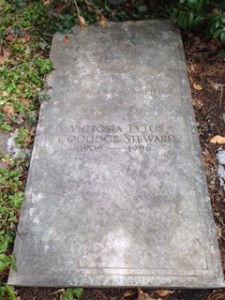 Riffing on something Chris Child wrote about collecting photos of family members in July, I thought I might do something similar with information about family burial plots. Such an exercise leans heavily on Findagrave.com (where some of the images may be found), although in my case I also have the notes compiled by my great-aunt Margaret Steward in 1966 as a resource for my research.
Riffing on something Chris Child wrote about collecting photos of family members in July, I thought I might do something similar with information about family burial plots. Such an exercise leans heavily on Findagrave.com (where some of the images may be found), although in my case I also have the notes compiled by my great-aunt Margaret Steward in 1966 as a resource for my research.
My grandparents are easy: my father’s parents (and stepmother) are buried at Hamilton Cemetery in Massachusetts, while my mother’s parents (and stepmother) are buried at Arlington National Cemetery in Virginia. I was present for my paternal grandfather’s memorial service in 1991, my maternal grandfather’s burial in 1994, and for my paternal step-grandmother’s memorial service in 1996. Continue reading Family plots: Part Two
The introduction of photography

Perhaps more than any other event, the introduction of photography altered how individuals were memorialized and are remembered. While portraits have been produced for thousands of years, photographic images were first introduced about 1838 and the first known photograph to contain people was produced between April and May of that year.[1] This photograph is of the Boulevard du Temple in Paris, and due to the long exposure time of about ten to twelve minutes, all people in the photograph moved and avoided being captured in the image, with the exception of a man having his shoes shined who remained still for the length of the exposure.[2] Continue reading The introduction of photography
A research exercise updated
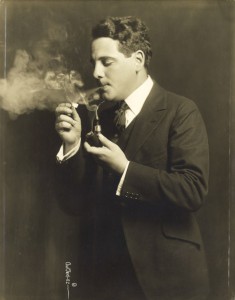
Nine Vita Brevis readers took the plunge and sent in a set of complete answers to Monday’s research challenge. Thank you all for participating!
The winner had ten answers correct out of eleven; not a single person identified Monroe Salisbury (1876–1935), who played the second-billed Earl of Kerhill in Cecil B. DeMille’s 1914 western The Squaw Man.[1] Only one person correctly identified Milton Sills (1882–1930) as Gloria Swanson’s co-star in The Great Moment (1921); the general feeling among respondents was that Wallace Reid (1891–1923), who acted with Swanson in DeMille’s The Affairs of Anatol and Sam Wood’s Don’t Tell Everything (both 1921), was the man in the picture. Continue reading A research exercise updated
Mrs. Gray on marriage
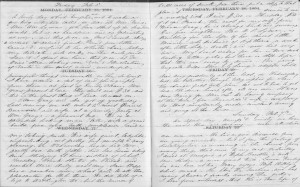
Regina Shober Gray’s diary abounds in telling details and contemporary gossip; in some ways, her views on the marriages (and marriage prospects) of her friends call out some of her choicest phrasing:
Boston, ca. Sunday, 5 January 1873: Our cousin John C. Gray, jr.[1]’s engagement to Nina Mason (daughter of the late Rev. Charles M.[2]) was announced yesterday. She is 19 – he 33 or 34, a great difference at her age. On dit[3] he fell very desperately in love with her when travelling in Europe – and that her mother would not consent to any engagement till the child had seen at least one year of home society, thinking very naturally Nina was too young & inexperienced to know her own mind.
Sunday, 19 January 1873: Poor young Nellie U[4]’s miserable entanglement with Charles Walker has come to a crisis at last, after having been town talk for more than two years; and in all that time, no whisper or suspicion has reached her parents’ ears. Continue reading Mrs. Gray on marriage
A research exercise

I tried this for July 4, and thought it might be fun to try it again: I have several photos of Hollywood actors and actresses associated with a director and a film, and I wonder if some Vita Brevis readers can square the circle and identify the photos’ subjects. Continue reading A research exercise
“Free access”
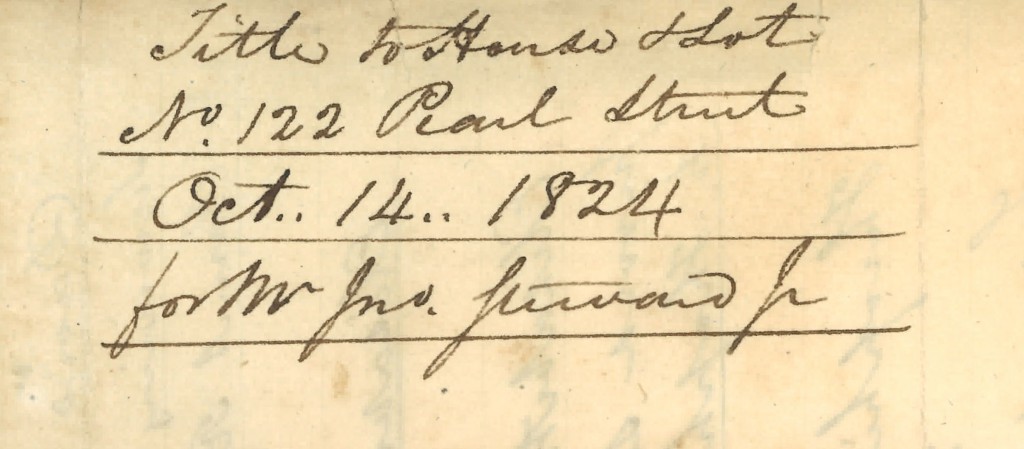 It was a matter of some pride to my grandfather that his great-grandfather John Steward (1777–1854) bought the (downtown) Gracie Mansion[1] when he moved to New York more than two hundred years ago. Perhaps so, as John Steward lived at 1 Pearl Street until he moved far uptown to a new house at Fifth Avenue and Twenty-first Street, shortly before his death in 1854. The title abstracts in my grandfather’s box of family papers concerning John’s Pearl Street real estate are for some other properties – one was his store, at 80 Pearl Street,[2] while another (122 Pearl Street) was purchased from Mr. and Mrs. Charles McEvers. Continue reading “Free access”
It was a matter of some pride to my grandfather that his great-grandfather John Steward (1777–1854) bought the (downtown) Gracie Mansion[1] when he moved to New York more than two hundred years ago. Perhaps so, as John Steward lived at 1 Pearl Street until he moved far uptown to a new house at Fifth Avenue and Twenty-first Street, shortly before his death in 1854. The title abstracts in my grandfather’s box of family papers concerning John’s Pearl Street real estate are for some other properties – one was his store, at 80 Pearl Street,[2] while another (122 Pearl Street) was purchased from Mr. and Mrs. Charles McEvers. Continue reading “Free access”
“The bitter end”

One of the most remarkable entries in the Regina Shober Gray diary – a document not short on remarkable entries – is the one where the diarist recounts a vivid dream in which she is a murderess. In the dream, as she says, she felt no “remorse or horror (for I did not deny the murder), but only a dull, stolid amazement that I should find myself in this disastrous, mortifying position.”[1]
The cool appraisal with which the diarist considers her feelings and motivations, the lack of self-consciousness about her professed guilt, and the ease with which she insists that she is a “lady” suggest that the diary was never meant to be read by others. Continue reading “The bitter end”
The horse he rode in on
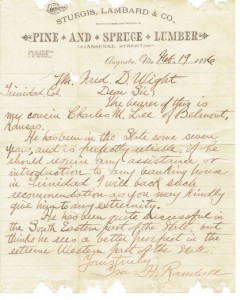
Every family history researcher hopes diligence and persistence will bring forth enough details of an ancestor’s life to fill out a void on the family tree. There is always hope that serendipity will produce unexpected history gold in letters, diaries, or journals. Charles Merrill Lee (1860–1887) is one of those relatives who stand in the background of family research until the odd paper comes to hand or an old memory nags at the brain.
My grandmother always called him “Uncle Charlie.” Born in Maine, Charlie was four years younger than her father Fred Lee. Uncle Charlie was seldom mentioned, in my presence anyway, and usually in regretful tones. My questions were unanswered, and a search of the usual public records yielded little information. Continue reading The horse he rode in on
Unintended consequences
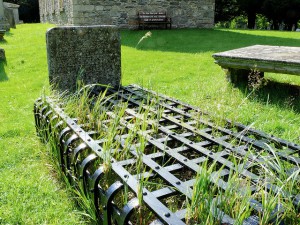 After the turn of the nineteenth century, the number of medical schools around the world increased significantly. While the increase in these institutions led to monumental developments in the medical field, it also had previously unforeseen consequences. One such consequence was a shortage of bodies for dissection and examination. Continue reading Unintended consequences
After the turn of the nineteenth century, the number of medical schools around the world increased significantly. While the increase in these institutions led to monumental developments in the medical field, it also had previously unforeseen consequences. One such consequence was a shortage of bodies for dissection and examination. Continue reading Unintended consequences